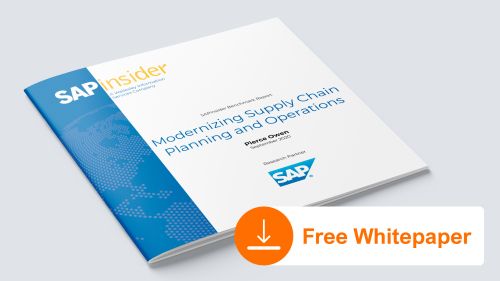Whitepaper: Modernizing Supply Chain Planning and Operations Benchmark Report

Now more than ever, in a year marked by the need to adjust to massive changes in business, restricted shipping capabilities, and limited providers, supply chain managers need modern planning tools to adapt to the volatility of the market as well as the ability to share and execute their plans. These tools include demand, supply, and inventory planning solutions; sales and operations planning (S&OP) solutions; integrated supplier networks; real-time production scheduling; automated data management solutions; and self-service analytics solutions.
Read the report to:
- Learn what drives organizations in their approach to Supply Chain Planning and Operations
- Discover the top requirements for supply chain planning and operations
- Gain your steps to success for modernizing supply chain planning and operations
What is it all about?
In Q3 of 2020, SAPinsider surveyed 298 members of our community to understand their needs in supply chain planning and operations. We found that SAP Integrated Business Planning for Supply Chain (IBP) represented the most popular dedicated planning solution among respondents with 39% using SAP IBP.
When it comes to managing the supply chain with ERP, 64% of respondents use SAP ERP Central Component (ECC), while 25% have upgraded to SAP S/4HANA. Both SAP ECC and SAP S/4HANA have Material Requirements Planning (MRP) capabilities, and SAP S/4HANA now has advanced available-to-promise (aATP), embedded analytics, and realtime production scheduling; however, neither of these systems include S&OP nor advanced demand and supply forecasting.
Conversely, SAP IBP does include S&OP and demand and supply planning, but it does not include real-time production scheduling.
SAP IBP customers had the highest satisfaction rates with 58% saying their solutions met their needs and 85% able to measure forecast accuracy today. With comparable on-time fill rates, GIB customers followed closely with 57% saying their solutions met their needs and 74% able to measure forecast accuracy.
Those using GIB had better operational visibility with 64% saying they had the visibility, quality, and granularity they need for supply chain operational data versus 57% of SAP IBP customers.
The survey results revealed several other trends for supply chain planning and operations in the SAPinsider Community:
- Outside of SAP's own products and the GIB Suite, no solution had more than 4% market share among respondents.
- Regarding product orders from the past year, respondents had a median on-time fill rate or on-time demand satisfaction rate (orders shipped on-time or early/orders placed) of 83%. The top quartile had ontime fill rates of 94% or better, while the bottom quartile had rates of 77% or worse.
- Respondents chose "Modernizing demand and supply forecasting to make data-driven decisions" as the most popular key strategy (62%).
- Respondents chose a deep integration between supply chain planning and operational execution as the most important requirement for a successful supply chain planning and operations strategy (87% selected as important or very important).
Required Actions
Supply chain managers and demand planners must consider taking the following actions to ensure success:
- Identify the best data to drive demand forecasts.
Most respondents (81%} ranked data-driven demand forecasts as important or very important. However, it will take an ongoing process to identify the right data to drive forecasts, and demand planners must work with the best available data. They will need to constantly test and combine parameters and data sources in different ways to learn how to get the most accurate possible forecasts and better results. - Evaluate solutions for supply chain planning and operations that integrate with SAP ERP and SAP S/4HANA.
Not every supply chain will require dedicated planning solutions, but most survey respondents have at least started evaluating such solutions. Survey respondents also agree on the importance of integration between supply chain planning and operational execution (88%) and that of an ERP that supports production scheduling and available-to-promise (76%). - When implementing SAP S/4HANA, prioritize supply chain professionals' access to data and ability to allocate inventory.
One survey respondent explained how a botched ERP implementation left the organization with stores and warehouses that could no longer allocate products for customers on demand. Educate employees and test ERP setup and integrations to avoid these integration and usage issues.


